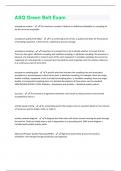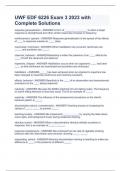ASQ Green Belt Exam acceptance number - The maximum number of defects or defectives allowable in a sampling lot for the lot to be acceptable. acceptance quality limit (AQL) - In a continuing series of lots, a quality level that, for the purpose of sampling inspection, is the limit of a satisfactory process average. acceptance sampling - Inspection of a sample from a lot to decide whether to accept that lot. There are two types: attributes sampling and variables sampling. In attributes sampling, the presence or absence of a characteristic is noted in each of the units inspected. In variabl es sampling, the numerical magnitude of a characteristic is measured and recorded for each inspected unit; this involves reference to a continuous scale of some kind. acceptance sampling plan - A specific plan that indicates the sampling sizes and associated acceptance or nonacceptance criteria to be used. In attributes sampling, for example, there are single, double, multiple, sequential, chain, and skip -lot sampling plans. In variables sampling , there are single, double, and sequential sampling plans. For detailed descriptions of these plans, see the standard ANSI/ISO/ASQ A3534 -2-1993: Statistics —Vocabulary and symbols — Statistical quality control. accuracy - The closeness of agreement between a test result or measurement result and the accepted/true value.2 activity based costing - An accounting system that assigns costs to a product based on the amount of resources used to design, order, or make it. activity network diagram - A diagram that links tasks with direct arrows showing the path through the task list. Tasks are linked when a task is dependent on a preceding task. (AKA arrow diagram.) Included with parallel activity paths Advanced Product Quality Planning (APQP) - High -level automotive process for product realization, from design through production part approval. affinity diagram - A management tool for organizing information (usually gathered during a brainstorming activity) into categories. To group ideas for a new or potentially complex problem, a team would most likely employ: American National Standards Institute (ANSI) - A private, nonprofit organization that administers and coordinates the U.S. voluntary standardization and conformity assessment system. It is the U.S. member body in the International Organization for Standardization, known as ISO. American Society for Quality (ASQ) - A global community of people dedicated to quality who share the ideas and tools that make our world work better. With individual and organizational members around the world, ASQ has the reputation and reach to bring together the diverse quality champions who are transforming the world's corporations, organizations, and communities to meet tomorrow's critical challenges. analysis of means (ANOM) - A statistical procedure for troubleshooting industrial processes and analyzing the results of experimental designs with factors at fixed levels. It provides a graphical display of data. Ellis R. Ott developed the procedure in 1967 because he observed that nonstatisticians had difficulty understanding analysis of variance. Analysis of means is easier for quality practitioners to use because it is an extension of the control chart. In 1973, Edward G. Schilling further extended the concept, enabling analysis o f means to be used with nonnormal distributions and attributes data in which the normal approximation to the binomial distribution does not apply. This is referred to as analysis of means for treatment effects. analysis of variance (ANOVA) - A basic statistical technique for determining the proportion of influence a factor or set of factors has on total variation. It subdivides the total variation of a data set into meaningful component parts associated with specific sources of variation to te st a hypothesis on the parameters of the model or to estimate variance components. There are three models: fixed, random, and mixed. Alternative hypothesis is valid for one way Anova is at least one of the group means is different. analytical (inferential) studies - A set of techniques used to arrive at a conclusion about a population based upon the information contained in a sample taken from that population. arrow diagram - A planning tool used to diagram a sequence of events or activities (nodes) and their interconnectivity. It is used for scheduling and especially for determining the critical path through nodes. (AKA activity network diagram.) assignable cause - A name for the source of variation in a process that is not due to chance and therefore can be identified and eliminated. Also called "special cause." attributes (discrete) data - Go/no -go information. The control charts based on attributes data include percent chart, number of affected units chart, count chart, count per unit chart, quality score chart, and demerit chart. attributes, method of - Method of measuring quality that consists of noting the presence (or absence) of some characteristic (attribute) in each of the units under consideration and counting how many units do (or do not) possess it. Example: go/no -go gauging of a dimension. audit - The on -site verification activity, such as inspection or examination, of a product, process, or quality system, to ensure compliance to requirements. Glossary 561 An audit can apply to an entire organization or might be specific to a product, function, pro cess, or production step. Automotive Industry Action Group (AIAG) - A global automotive trade association with about 1600 member companies that focuses on common business processes, implementation guidelines, education, and training. average chart - A control chart in which the subgroup average, x -, is used to evaluate the stability of the process level. average outgoing quality (AOQ) - The expected average quality level of an outgoing product for a given value of incoming product quality. average outgoing quality limit (AOQL) - The maximum average outgoing quality over all possible levels of incoming quality for a given acceptance sampling plan and disposal specification. average run length (ARL) - On a control chart, the number of subgroups expected to be inspected before a shift in magnitude takes place. average sample number (ASN) - The average number of sample units inspected per lot when reaching decisions to accept or reject. average total inspection (ATI) - The average number of units inspected per lot, including all units in rejected lots. Applicable when the procedure calls for 100 percent inspection of rejected lots. balanced scorecard - A management system that provides feedback on both internal business processes and external outcomes to continuously improve strategic performance and results. Four dimensions are: Financial, Customer, Internal process and Innovation Baldrige Award - See Malcolm Baldrige National Quality Award. baseline measurement —The beginning point, based on an evaluation of output over a period of time, used to determine the process parameters prior to any improvement effort; the basis against which change is measu red. batch and queue - Producing more than one piece and then moving the pieces to the next operation before they are needed. Bayes's theorem - A formula to calculate conditional probabilities by relating the conditional and marginal probability distributions of random variables. benchmarking - A technique in which a company measures its performance against that of best -
in-class companies, determines how those companies achieved their performance levels, and uses the information to improve its own performance. Subjects that can be benchmarked inc lude strategies, operations, and processes. benefit -cost analysis - An examination of the relationship between the monetary cost of implementing an improvement and the monetary value of the benefits achieved by the improvement, both within the same time period. 562 Glossary bias - The influence in a sample of a factor that causes the data population or process being sampled to appear different from what it actually is, typically in a specific direction.3





